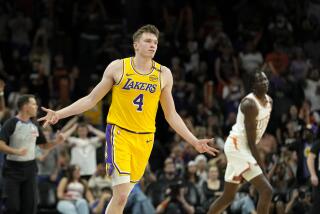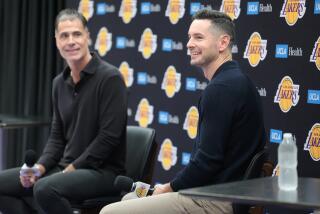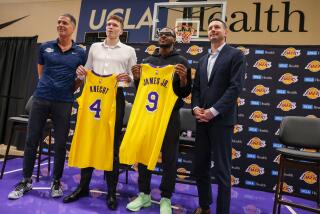A Pick With so Many Choices
The lottery assured the Lakers of the No. 10 pick in next monthâs draft. Now the more unpredictable part -- what to do with it.
They could keep it or trade it.
They could use it to fill a need in the post or at point guard, or simply take the best available player, even if it adds another small forward to a roster overrun with them.
They could prepare for the pick as if Phil Jackson were their next coach, with an emphasis on versatile small forwards and tall guards, or strategize without considering a specific coach and whatever system might come with him.
In short, with more than a month to go, the Lakersâ draft options are as limitless as they have been in years, perhaps a lone savory footnote to an unsettling 34-48 season.
The Lakers havenât had a pick this high since taking Eddie Jones 10th overall in 1994, although there are few franchise-changing types in what is considered a deep but not historic draft.
âThere isnât a Tim Duncan or Shaq [OâNeal] or some guy whoâs clearly the top pick and thereâs a lot of parity after you get by the first three guys,â said a player-personnel director for an NBA team. âBetween the next 10-15 guys, thereâs mostly a lot of depth.â
Because they have no salary-cap space to lure a big-name free agent, the Lakers will make most of their roster changes via trades and the June 28 draft -- they also have two second-round picks, Nos. 37 and 39.
Five Lakers are in the final year of their contracts, making them potentially valuable commodities for teams that want salary-cap flexibility after next season: Devean George ($5 million for 2005-06), Chucky Atkins ($4.5 million), Slava Medvedenko ($3 million), Caron Butler ($2.4 million) and Jumaine Jones ($1.9 million). The Lakers have the right to match if Butler signs an offer sheet with another team after next season.
The Lakers could package some of the players and the No. 10 pick to move up in the draft. Or they might stay where they are.
âWeâre approaching the draft as if we will keep the pick and draft at No. 10,â Laker General Manager Mitch Kupchak said. âThatâs been our approach, but we expect a lot of activity in the next two or three weeks with teams that are not in the playoffs and that may or may not involve our pick. Itâs tough to predict with any certainty exactly how weâre going to use the pick and even if we are going to have the pick.â
The Milwaukee Bucks, who defied a 6.3% chance and won the No. 1 pick in Tuesdayâs lottery, do not seem overly tempted to trade their selection, because they hope free-agent guard Michael Redd will re-sign with them if enough talent is added.
But the Portland Trail Blazers, the lotteryâs other winner when they moved from No. 5 to No. 3, are entertaining offers from other teams.
If the Lakers donât make a trade to climb in the draft, they must decide whether to fill a specific roster hole or take the best player still on the board.
Outside of Utah sophomore Andrew Bogut, the draftâs top post players are generally considered to be a year or two away, and the best point guards -- 5-foot-11 Chris Paul of Wake Forest and 6-3 Deron Williams of Illinois -- probably will be taken in the top four or five picks.
The Lakers are intrigued by Fran Vazquez, a physical 6-10 power forward from Spain who doesnât shy away from contact and tries to dunk almost every time in the post, but he could be taken a few spots before No. 10.
There are other possibilities, many players whom the Lakers will view at private workouts or at the Chicago pre-draft camp June 7-10.
Tiago Splitter, a 6-11 power forward from Brazil, was not originally considered a strong prospect, but his stock has improved with recent workouts and he can move well for a big man.
Pittsburghâs Chris Taft, a 6-10 sophomore, is a physical but inconsistent presence, more of a âpotentialâ pick after failing to build upon a noteworthy freshman season.
Martynas Andriuskevicius, a 7-3 center from Lithuania, has a good outside touch and defensive ability but needs to add weight and work on his post moves.
Arizona 7-foot senior Channing Frye has soft hands and good footwork but lacks body strength and averaged 7.5 rebounds over the last two seasons, one more per game than Arizona guard Hassan Adams.
As for point guards beyond Williams and Paul, North Carolina junior Raymond Felton led the Atlantic Coast Conference with 6.9 assists a game and 44% accuracy from three-point range but is listed at 6 feet, a problem if the Phil factor is involved.
If Jackson rejoins the Lakers, players with potential to thrive in the triangle offense become important. Jackson has always used taller guards -- Ron Harper, Brian Shaw, Kobe Bryant -- and there would be more of an inclination to take the best available player, perhaps even a versatile small forward who could also play guard, as opposed to filling a specific need.
The Lakers have four small forwards on the roster -- three if Luke Walton is not re-signed -- but an attractive prospect is New Mexicoâs Danny Granger, a 6-8 senior who has impressed scouts with strong all-around skills and has been compared to Scottie Pippen.
Another possibility is Martell Webster, a 6-7 small forward who declared for the draft after his senior season at Seattle Prep High. Webster has a solid outside shot but needs to go to the basket more often and create more shots for himself.
If the Lakers hold onto No. 10, it comes down to one question: Need or potential?
âThe simple answer is if there were players available with a similar level of talent, you draft based on need,â Kupchak said. âIf thereâs a player you felt had more potential at that time, then you would pick the better player regardless of need.â
More to Read
All things Lakers, all the time.
Get all the Lakers news you need in Dan Woike's weekly newsletter.
You may occasionally receive promotional content from the Los Angeles Times.







